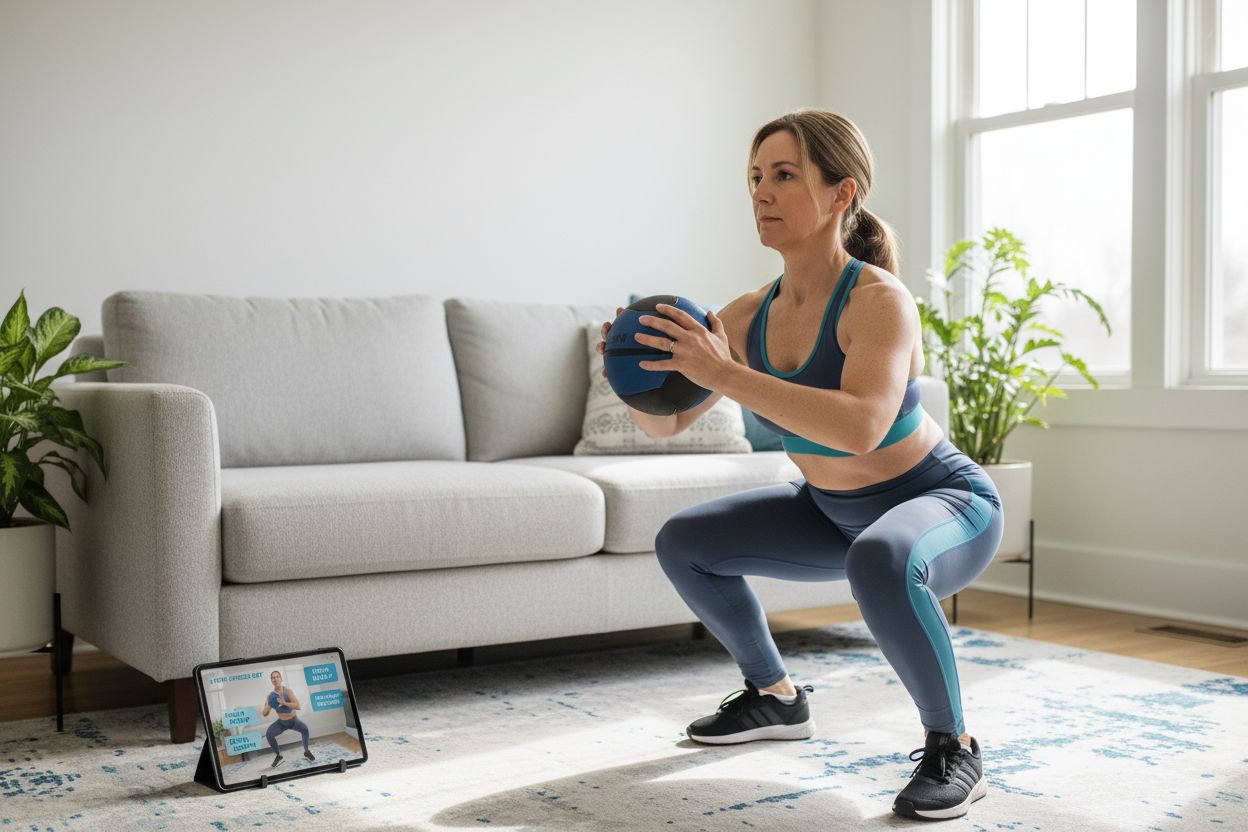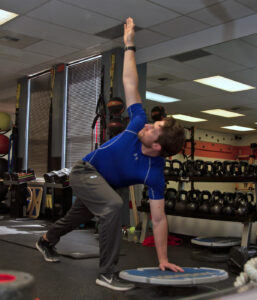Nearly 80 percent of adults experience lower back pain at some point, often caused by weak or imbalanced muscles. That simple statistic reveals how deeply our daily movements affect well-being as we age. Functional training offers a smarter path by focusing on exercises that mirror real-life actions. This approach helps you gain true strength, improve balance, and protect your body against everyday injuries as you move through life.
Key Takeaways
| Point | Details |
|---|---|
| Functional Training Fundamentals | Focuses on comprehensive muscle engagement to replicate real-world movements, enhancing strength and reducing injury risk. |
| Benefits for Daily Life | Improves coordination, balance, and overall mobility, enabling individuals to perform everyday tasks more easily. |
| Comparison with Traditional Workouts | Offers a full-body workout approach, contrasting with traditional methods that primarily isolate muscle groups for aesthetic goals. |
| Safety Considerations | Emphasizes proper form, gradual progression, and core engagement to minimize injury risks, especially for older adults. |
Table of Contents
- Defining Functional Training And Core Concepts
- Types Of Functional Training Exercises
- How Functional Training Improves Daily Life
- Comparing Functional Training To Traditional Workouts
- Addressing Safety, Risks, And Common Mistakes
Defining Functional Training and Core Concepts
Functional training represents a revolutionary approach to fitness that transforms how we think about exercise. Functional fitness goes beyond traditional weightlifting by training your body to perform real-world movements with greater ease and reduced injury risk. According to research from Wikipedia, this exercise approach specifically targets movements you naturally perform in daily life—like lifting groceries, climbing stairs, or picking up grandchildren.
At its core, functional training focuses on comprehensive muscle engagement instead of isolating muscle groups. The methodology involves exercises that mimic actual physical tasks, recruiting multiple muscle groups simultaneously. For middle-aged and retired individuals, this means building practical strength that translates directly into improved quality of life. Learn more about our functional training approach to understand how we customize these workouts for your specific needs.
Key characteristics of functional training include:
- Engages multiple muscle groups concurrently
- Improves overall body coordination and stability
- Enhances balance and flexibility
- Mimics real-world movement patterns
- Accessible across different fitness levels
Closed kinetic chain exercises, which are fundamental to functional training, involve movements where your hands or feet remain fixed during the exercise—think push-ups, squats, and lunges. These exercises are particularly effective because they simultaneously activate numerous muscle groups, providing a more holistic and efficient workout compared to traditional isolation movements.
Types of Functional Training Exercises
Functional training exercises are designed to mirror real-life movements, making them incredibly practical for individuals of all fitness levels. According to research from Wikipedia, these exercises include a diverse range of movements that engage multiple muscle groups simultaneously, providing comprehensive body conditioning that extends far beyond traditional workout routines.
Upper body functional exercises focus on movements that replicate everyday actions. These include push-ups, pull-ups, and dips, which not only build strength but also improve joint stability and muscular coordination. Explore our personalized functional training programs to discover how these exercises can be tailored to your specific fitness goals and physical capabilities.
Lower body functional training encompasses powerful movements that enhance overall mobility and strength:
- Squats: Mimics sitting and standing motions
- Lunges: Improves balance and leg strength
- Deadlifts: Trains posterior chain muscles
- Power cleans: Develops explosive strength
Additional functional training exercises include kettlebell swings, resistance band routines, and medicine ball workouts. These dynamic movements challenge your body through integrated, compound patterns that build functional strength, improve coordination, and increase overall fitness efficiency. By incorporating these exercises, you’re not just working out—you’re training your body to perform better in everyday life.

How Functional Training Improves Daily Life
Functional training is not just about building muscle—it’s about creating a body that performs seamlessly in everyday life. According to research from Wikipedia, this training approach dramatically enhances coordination, stability, and flexibility, making routine tasks significantly easier. Imagine lifting groceries, playing with grandchildren, or climbing stairs without strain—that’s the transformative power of functional fitness.
At its core, functional training prepares your body for real-world challenges. Discover how we support your longevity journey, focusing on movements that directly translate to daily activities. Whether you’re twisting to reach a high shelf, bending to tie your shoes, or carrying packages, these exercises train your muscles to work together efficiently.
Key benefits of functional training for daily life include:
- Reduced injury risk
- Improved core strength
- Enhanced balance and posture
- Better overall mobility
- Increased mental focus
By mimicking natural movement patterns, functional training helps middle-aged and retired individuals maintain independence and confidence. These targeted exercises aren’t just workouts—they’re practical training sessions that make everyday movements smoother, safer, and more comfortable. The result? A more capable, resilient version of yourself that can tackle physical challenges with greater ease and less fatigue.
Comparing Functional Training to Traditional Workouts
Traditional workouts and functional training represent two distinctly different approaches to fitness, each with unique philosophies and outcomes. According to research from Byrdie, traditional strength training typically involves isolating specific muscle groups using machines or heavy weights, focusing primarily on muscle growth and aesthetic development. In contrast, functional training embraces dynamic, full-body movements that enhance overall physical performance and practical strength.
The key differences become apparent in movement patterns and exercise goals. Learn more about our strength training philosophy, which bridges the gap between traditional and functional approaches. Traditional exercises often rely on structured, repetitive motions that target individual muscle groups, while functional training integrates compound movements that mimic real-life activities—improving coordination, balance, and joint stability simultaneously.
Comparative highlights between traditional and functional training include:
Traditional Workouts:
- Muscle isolation
- Machine-based exercises
- Aesthetic-focused results
- Structured, predictable movements
Functional Training:
- Full-body engagement
- Minimal equipment needed
- Practical movement improvement
- Dynamic, multi-joint exercises
For middle-aged and retired individuals, functional training offers significant advantages. It goes beyond mere muscle building, focusing instead on creating a body that moves efficiently, reduces injury risk, and supports everyday activities. The holistic approach means you’re not just working out—you’re training your body to perform better in real-world scenarios, making functional training a more comprehensive and practical fitness strategy.

Here’s a comparison of traditional workouts and functional training:
| Feature | Traditional Workouts | Functional Training |
|---|---|---|
| Muscle Focus | Isolated muscles | Multiple muscle groups |
| Equipment | Machines Heavy weights | Minimal Bodyweight Bands |
| Movement Type | Structured Predictable | Dynamic Real-life pattern |
| Primary Goal | Muscle growth Aesthetics | Practical strength Mobility |
| Accessibility | Some experience needed | Adaptable to all levels |
| Risk of Overuse Injury | Higher with repetition | Lower with varied patterns |
Addressing Safety, Risks, and Common Mistakes
Safety is paramount in functional training, especially for middle-aged and retired individuals. According to research from Wikipedia, effective functional training programs must be carefully individualized, integrated, and progressively designed to minimize injury risks. Without proper technique and personalized approach, participants can develop poor movement patterns that compromise their physical well-being.
Our personalized training approach focuses on gradual progression and precise technique. Common mistakes in functional training include neglecting core engagement, performing multi-joint exercises with improper form, and advancing too quickly without building foundational strength. These errors can lead to unnecessary strain and potential injury, particularly for individuals in middle age or retirement.
Key safety considerations for functional training include:
- Always prioritize proper form over lifting heavier weights
- Start with low-intensity movements
- Engage core muscles during all exercises
- Use professional guidance for complex movements
- Listen to your body and avoid overexertion
For middle-aged and retired individuals, functional training should emphasize stabilizing muscles and movement quality over intensity. By focusing on controlled, purposeful movements and working with trained professionals who understand age-related physical limitations, you can safely enjoy the comprehensive benefits of functional training while minimizing potential risks.
Ready to Make Everyday Movement Effortless?
Struggling to carry groceries, keep up with family, or just feel strong as you age? The challenges highlighted in our article about functional training—like improving balance, building practical strength, and protecting your joints—are exactly what we help clients conquer every day. We know that real results mean more than just lifting weights in the gym. You want to live life with energy and confidence. Dive deeper by visiting our Uncategorized Denver Personal Trainer Archives for real strategies designed for people just like you.
If you are ready to transform your strength, mobility, and overall health, now is your moment. Take the first step with Inner Evolution Fitness and discover how our personalized training approach uses functional movements to turn everyday problems into everyday victories. Your healthiest years can still be ahead—visit us now and see what a difference the right coaching can make.
Frequently Asked Questions
What is functional training?
Functional training is a fitness approach that focuses on exercises that mimic real-world movements, engaging multiple muscle groups simultaneously to improve strength, coordination, balance, and overall fitness efficiency.
How does functional training differ from traditional workouts?
Functional training emphasizes dynamic, full-body movements that replicate everyday tasks, while traditional workouts often isolate specific muscle groups through structured, machine-based exercises targeting muscle growth and aesthetics.
What are some common functional training exercises?
Common functional training exercises include push-ups, squats, lunges, kettlebell swings, and deadlifts. These exercises are designed to improve mobility, strength, and stability, making everyday activities easier and safer.
How can functional training improve my daily life?
Functional training enhances coordination, stability, and flexibility, making routine tasks such as lifting, bending, and climbing stairs easier and safer. It reduces the risk of injury and helps maintain independence as you age.
Recommended
- Functional Training – Denver Personal Trainer
- The Hidden Benefits of Strength Training for Your Brain and How To Train – Denver Personal Trainer
- Unleashing the Power Within – Denver Personal Trainer
- The Evolution of Personal Training – Denver Personal Trainer
- Unveiling The Power Of Free Weights And Muscle Growth


